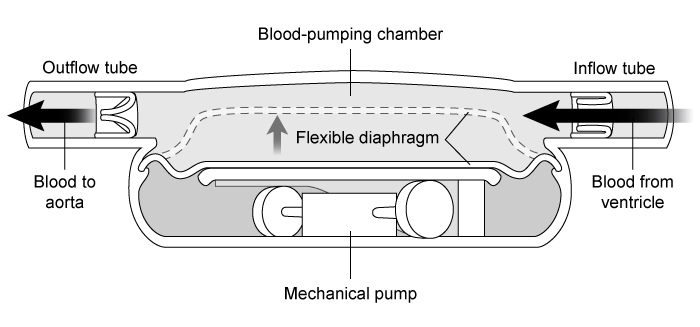Passage
In the event of end-stage heart failure, a left ventricular assist device (LVAD) can be used as a heart transplant bridge to keep a patient alive. The first iterations of LVADs were pulsatile and mimicked the physiological pumping action of the heart (Figure 1) .
 Figure 1 A pulsatile-flow LVAD schematicA pulsatile-flow LVAD assists ventricular systole by mechanically pumping blood from a weakened left ventricle into the aorta through a pair of one-way valves. The pressure differential ΔP generated by the pump is related to cardiac output (CO) and vascular resistance (VR) :ΔP = CO × VREquation 1The efficiency and performance of the heart (or LVAD) can be determined by the patient's cardiac pressure-volume (PV) loop. A cardiac PV loop plots the pressure and volume of the blood in the left ventricle throughout a single cardiac cycle (Figure 2) .
Figure 1 A pulsatile-flow LVAD schematicA pulsatile-flow LVAD assists ventricular systole by mechanically pumping blood from a weakened left ventricle into the aorta through a pair of one-way valves. The pressure differential ΔP generated by the pump is related to cardiac output (CO) and vascular resistance (VR) :ΔP = CO × VREquation 1The efficiency and performance of the heart (or LVAD) can be determined by the patient's cardiac pressure-volume (PV) loop. A cardiac PV loop plots the pressure and volume of the blood in the left ventricle throughout a single cardiac cycle (Figure 2) .
 Figure 2 Cardiac PV Loop of a pulsatile-flow LVADBlood pressure is often represented by only two numbers: arterial systolic and diastolic pressures. A more detailed representation of blood pressures is shown in a blood pressure profile, which graphs the blood pressure throughout the length of the different vessel groups (Figure 3) . Multiple pressure fluctuations are shown within a vessel because the pressure is traced across multiple cardiac cycles.
Figure 2 Cardiac PV Loop of a pulsatile-flow LVADBlood pressure is often represented by only two numbers: arterial systolic and diastolic pressures. A more detailed representation of blood pressures is shown in a blood pressure profile, which graphs the blood pressure throughout the length of the different vessel groups (Figure 3) . Multiple pressure fluctuations are shown within a vessel because the pressure is traced across multiple cardiac cycles.
 Figure 3 Blood pressure profile of the different vessels
Figure 3 Blood pressure profile of the different vessels
- In the above figure, an LVAD pump is placed at one end of a "U"-shaped container, and a force gauge is placed at the other end. If the container is filled with an incompressible fluid, what is the ratio of the force measured by the force gauge to the force exerted by the LVAD?
In the above figure, an LVAD pump is placed at one end of a "U"-shaped container, and a force gauge is placed at the other end. If the container is filled with an incompressible fluid, what is the ratio of the force measured by the force gauge to the force exerted by the LVAD?
A) 1:4
B) 1:2
C) 1:1
D) 4:1
Correct Answer:
Verified
Q56: Passage
When present in the bloodstream above a
Q57: Passage
When present in the bloodstream above a
Q58: Passage
The effects of gravity are effectively negated
Q59: Passage
The effects of gravity are effectively negated
Q60: Passage
In mass spectrometry, a sample's molecules are
Q62: Passage
Sound waves propagate through many conducting structures
Q63: Passage
Ultrasound is a technique that uses the
Q64: Passage
Ultrasound is a technique that uses the
Q65: Passage
Positron emission tomography (PET) is a medical
Q66: Passage
Positron emission tomography (PET) is a medical
Unlock this Answer For Free Now!
View this answer and more for free by performing one of the following actions

Scan the QR code to install the App and get 2 free unlocks

Unlock quizzes for free by uploading documents